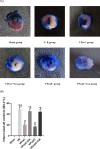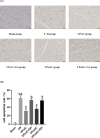Heat shock protein 90 mediates the protective effects of vericiguat on myocardial ischemia/reperfusion injury by inhibiting toll-like receptor 4 and c-Jun N-terminal kinases
- PMID: 40809170
- PMCID: PMC12340413
- DOI: 10.22038/ijbms.2025.84354.18248
Heat shock protein 90 mediates the protective effects of vericiguat on myocardial ischemia/reperfusion injury by inhibiting toll-like receptor 4 and c-Jun N-terminal kinases
Abstract
Objectives: This study aimed to investigate whether vericiguat exerts a protective effect against myocardial ischemia-reperfusion injury (MIRI) by inhibiting toll-like receptor 4 (TLR4) and c-Jun N-terminal kinases (JNK) activation and whether heat shock protein 90 (HSP90) mediates these effects.
Materials and methods: A total of 120 male mice were randomly divided into six groups: sham, ischemia/reperfusion (I/R group), VPreC (vericiguat, 3 mg/kg, administered intravenously 12 hr before ligation), VPreC+HSP90 inhibitor geldanamycin (GA) (geldanamycin, 1 mg/kg, injected intraperitoneally 30 min before ligation), VPostC (vericiguat, 3 mg/kg, administered intravenously ten minutes before reperfusion), and VPostC+GA (geldanamycin, 1 mg/kg, injected intraperitoneally 20 min before reperfusion). The remaining five groups were subjected to 30 min of ischemia followed by two hours of reperfusion. The sizes of myocardial infarction, rates of cardiomyocyte apoptosis, and levels of myocardial markers were measured. In addition, the protein expressions of HSP90, TLR4, JNK, BAX, and B-lymphoblastoma-2 (Bcl-2) were detected, along with the mRNA levels of inflammatory factors.
Results: Vericiguat significantly reduced I/R-induced myocardial infarct size, apoptosis rate, and myocardial marker release. Alongside these positive effects, there was an increase in HSP90 and Bcl-2 expression, as well as a decrease in TLR4, JNK, BAX expression, and inflammatory factor levels. However, the HSP90 inhibitor GA reversed these protective and anti-inflammatory effects.
Conclusion: HSP90 mediates the cardioprotective effects of vericiguat, potentially by inhibiting TLR4, JNK activation, and inflammatory responses.
Keywords: HSP90; Ischemic postconditioning Ischemic preconditioning JNK; TLR4; Vericiguat.
© 2025. This work is openly licensed via CC BY 4.0.
Conflict of interest statement
The authors declared no potential conflicts of interest regarding the research, authorship, and publication of this article.
Figures







Similar articles
-
Exosomal HSP90 induced by remote ischemic preconditioning alleviates myocardial ischemia/reperfusion injury by inhibiting complement activation and inflammation.BMC Cardiovasc Disord. 2023 Feb 1;23(1):58. doi: 10.1186/s12872-023-03043-y. BMC Cardiovasc Disord. 2023. PMID: 36726083 Free PMC article.
-
Cardioprotective Effects of Bosentan in Rats Subjected to Lung Ischemia-Reperfusion Injury.Medicina (Kaunas). 2025 Jul 18;61(7):1298. doi: 10.3390/medicina61071298. Medicina (Kaunas). 2025. PMID: 40731929 Free PMC article.
-
Andrographolide Attenuates Myocardial Ischemia-Reperfusion Injury in Mice by Up-Regulating PPAR-α.Inflammation. 2025 Aug;48(4):2341-2354. doi: 10.1007/s10753-024-02193-1. Epub 2024 Nov 25. Inflammation. 2025. PMID: 39585583
-
The Black Book of Psychotropic Dosing and Monitoring.Psychopharmacol Bull. 2024 Jul 8;54(3):8-59. Psychopharmacol Bull. 2024. PMID: 38993656 Free PMC article. Review.
-
NTP Developmental and Reproductive Toxicity Technical Report on the Prenatal Development Studies of 2-((1-(4-Phenoxyphenoxy)propan-2-yl)oxy)pyridine (CASRN 95737-68-1) in Sprague Dawley (Hsd:Sprague Dawley® SD®) Rats and New Zealand White (Hra:NZW SPF) Rabbits: DART Report 07 [Internet].Research Triangle Park (NC): National Toxicology Program; 2022 Jan. Research Triangle Park (NC): National Toxicology Program; 2022 Jan. PMID: 35593777 Free Books & Documents. Review.
References
-
- Barrère-Lemaire S, Vincent A, Jorgensen C, Piot C, Nargeot J, Djouad F. Mesenchymal stromal cells for improvement of cardiac function following acute myocardial infarction: A matter of timing. Physiol Rev. 2024;104:659–725. - PubMed
-
- Welt FGP, Batchelor W, Spears JR, Penna C, Pagliaro P, Ibanez B, et al. Reperfusion injury in patients with acute myocardial infarction: JACC scientific statement. J Am Coll Cardiol. 2024;83:2196–2213. - PubMed
-
- Pieske B, Butler J, Filippatos G, Lam C, Maggioni AP, Ponikowski P, et al. Rationale and design of the SOluble guanylate Cyclase stimulatoR in heArT failurE Studies (SOCRATES) Eur J Heart Fail. 2014;16:1026–1038. - PubMed
-
- Armstrong PW, Pieske B, Anstrom KJ, Ezekowitz J, Hernandez AF, Butler J, et al. Vericiguat in patients with heart failure and reduced ejection fraction. N Engl J Med. 2020;382:1883–1893. - PubMed
LinkOut - more resources
Full Text Sources
Research Materials
Miscellaneous
